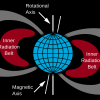The Van Allen Radiation Belts
Earth’s magnetic field protects the surface from cosmic radiation and charged particles from the Sun. While it seems like the magnetic field is a giant force field deflecting harmful particles far away into the universe, it’s actually doing the opposite. Magnetized planets like Earth have layers of charged particles trapped by the magnetic field. Earth has two of these layers known as Van Allen radiation belts.
Most of the charged particles trapped in Earth’s magnetosphere are from solar winds and some from cosmic rays. The belts, located within the inner region of Earth’s magnetosphere, are named after James Van Allen. James Van Allen was an American space scientist at the University of Iowa who helped establish the field of magnetospheric space research. He’s credited with discovering Earth’s radiation belts in 1958.
Because the Van Allen belts mostly consist of charged particles from solar winds, extreme space weather can have a major effect on these layers of radiation. In 2013, extreme space weather caused the appearance of a third Van Allen belt, which lasted a few weeks before disappearing. Researchers at the University of Alberta discovered that “space tsunamis” create a mysterious third Van Allen belt. These space tsunamis consist of intense plasma waves that shift the regular two belts. Usually, Earth’s magnetosphere has an inner belt, 1,000 to 6,000 km above the surface, and an outer belt, 13,000 to 60,000 km above the surface. The plasma waves act like a tsunami and wash away the outer Van Allen belt separating into a third layer.
Other magnetized planets can have layers of high-energy protons and electrons trapped in their magnetospheres as well if they have strong magnetic fields. Jupiter, Neptune, and Uranus all have confirmed radiation belts while planets like Venus, Mars, and Mercury don’t have sufficient magnetic fields to sustain radiation layers.
The research conducted by NASA’s Van Allen probes helps reduce threats to satellites like those we use for navigation and telecommunication. Predicting solar storms and other space weather is important to protecting satellites from the harmful space radiation in concentrated layers in Earth’s magnetosphere.

